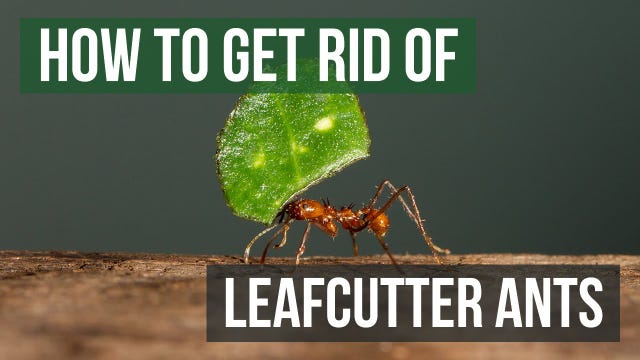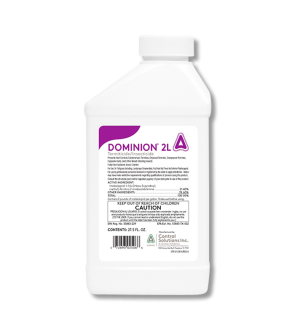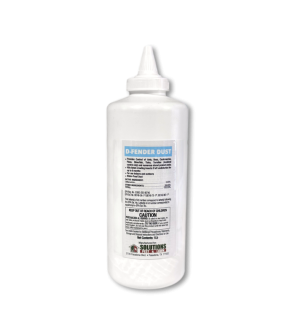Gain access to personalized product screening, the best pricing, rewards, and more!
Most Effective Products
Leaf Cutter Ant Control: How To Get Rid of Leaf Cutter Ants
This page is a leaf cutter ant control guide. Follow it and use the recommended products, and we guarantee your yard will be free of damage from leaf cutter ants.
The leaf cutter ant (a.k.a. parasol ant or town ant) is an ant species known for cutting and carrying leaves back to their nest to cultivate fungus. This ant type is typically a problem in rural or agricultural areas but has steadily become a more common threat in residential settings, especially in Texas.
Leaf cutter ants and their colonies can be found in various habitats, such as yards, meadows, next to roads, fields, woody areas, and where the soil is deep enough to create colonies. A single colony of leaf cutter ants can have up to 2 million ants living in it.
Leaf cutter ants create their food source by using leaf clippings that they return to their nest. They feed off a fungus garden grown by the chewed leaves they collect. This is why you'll always see them carrying bits of leaves on their foraging trails. If your field, garden, or property offers them plenty of vegetation, they will set up camp and begin to collect leaves.
Leaf cutter ants are mainly a problem for agricultural fields and gardens. If their population is unchecked, small and young trees can be quickly defoliated and die. Even medium-sized trees can be defoliated in a single night by large leaf-cutter ant colonies. This is why it's important to immediately address a leaf cutter ant infestation with professional pesticides.
If you encounter leaf cutter ants, follow our DIY Treatment guide below. It will give you the expert advice and product recommendations you need to totally get rid of them.
Identification
Before you can treat, you need to ensure you're dealing with leaf cutter ants. Fortunately, leaf cutter ants are easy to identify because you regularly see them carrying bits of vegetation. Below, we'll review the characteristics that set them apart from other ant species.
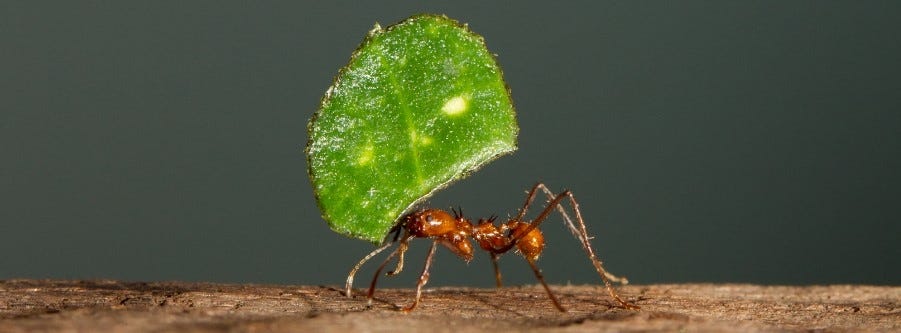
- Adult leaf cutter ants can be anywhere from 1/16 to 1/2 an inch in size, and adult leaf cutter ant queens vary between 3/4 and 2 inches in length.
- They are usually reddish brown or dark brown.
- The spines on their bodies can easily identify them.
- They are commonly seen carrying bits of vegetation on their foraging trails.
- Their dirt mounds are about 5 to 14 inches high and 1 foot (or larger) in diameter. Leaf cutter ant colonies are notoriously large. Most colonies can range in the millions of ants.
Inspection
Once you have confirmed that you are dealing with leaf cutter ants, you can proceed with the inspection. Carefully inspect your property for damage or dirt mounds they have created. This will help you figure out exactly where you need to focus your insecticide treatment.

Where To Inspect
Leaf cutter ants are usually active and a problem in rural or agricultural areas but have increasingly been pushing into residential areas. To look for activity, begin your inspection outdoors, as leaf cutter ants rarely invade indoor spaces.
Inspect your lawn, turf, or land, searching closely for vegetation, ornamental plants, and trees. Check where the soil is sandy and good for burrowing.
What To Look For
You're looking for leaf cutter ant dirt mounds and other signs of their activity. These mounds can be anywhere from 5 to 14 inches in size and have a diameter of 1 foot or longer.
During the summer, leaf cutter ants only forage at night. The rest of the year, they forage during the day, and you can see their foraging trails, which lead to the nest or their dirt mounds.
Treatment
Before treatment, read all product labels, follow the application instructions on these labels, and stay safe by wearing personal protective equipment (PPE).
Our main recommendation for addressing leaf cutter ant Infestations is an outdoor treatment of Dominion 2L. This powerful, non-repellent, systemic insecticide is great for treating ants because they are unable to detect it. This will help prevent scattering the colony.
Locating and drenching the mounds with Dominion 2L will effectively end the population and their damage.
Step 1: Mix and Apply Dominion 2L

Dominion 2L is a systemic insecticide containing Imidacloprid. It works by interfering with the insect's nervous system. Because it is a non-repellent systemic insecticide, ants will not be able to detect it as they pass through treated areas. They will also spread the product to other ants, creating a systemic elimination of an entire colony.
To apply Dominion 2L, it must be mixed with water. We recommend using a 1—to 1.5-gallon sprayer since you will be making localized treatments to the Leaf Cutter Mounds.
Measure the square footage of the treatment area to determine how much Dominion 2L you need to mix. To find the square footage, measure the treatment areas' length and width in feet, then multiply them together (length X width = square footage).
We suggest using a 0.05% (0.3 fl. oz.) to 0.1% (0.6 fl. oz.) dilution ratio in 1 gallon of water, which will usually treat 1,000 sq. ft. For a typical control situation, a 0.05% dilution is used. For more severe or persistent infestations, use the 0.1% dilution rate.
Fill your sprayer halfway with water, measure the appropriate amount of Dominion 2L, and fill the sprayer the rest of the way with water. Agitate the sprayer to mix the product well, and you're ready to apply.
Prevention
Once you have treated and killed the leaf cutter ant infestation, you will want to make sure they don't make a return. Total prevention of leaf cutter ants can be difficult but not impossible. Here are the preventative measures we suggest:
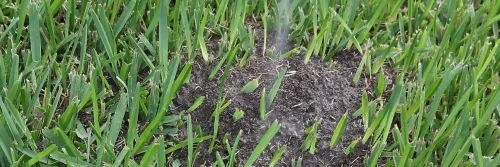
- For farms, plantations, crops, and fields susceptible to leaf cutter ant damage, we recommend diversifying your crops with different species of trees, which might reduce the damage that leaf cutter ants might create in these large areas.
- Applying Dominion 2L every quarter will protect your plants and trees. Drenching on the dirt mounds as soon as they appear may be necessary for continuous production and control.
- Clear up excess leaf litter and yard debris from the area to make the landscape less appealing for leaf cutter ant harborage.
Key Takeaways
What are Leaf Cutter Ants?
- Leaf cutter ants are plant-damaging ants that create large colonies in various landscapes.
- They stand out by their signature carrying large leaves as they return to their nests.
How To Get Rid of Leaf Cutter Ants
- We recommend applying Dominion 2L to Leaf Cutter Ant mounds as a drench treatment to control the leaf cutter ants and stop their damage.
- Dominion 2L is the recommended product because it is a non-repellent, systemic insecticide. This will help you get control of ants because they will not be able to detect the insecticide while also spreading it to their nest mates.
Preventing Leaf Cutter Ant Infestations
- Preventative applications of Dominion 2L can reduce the likelihood of leaf cutter ant re-infestation along with environmental modifications such as reducing leaf litter and yard debris.
- Check your property every 60 to 90 days to ensure no new ant mounds have appeared. If ant mounds are seen after that time, re-apply Dominion 2L for continued control.






